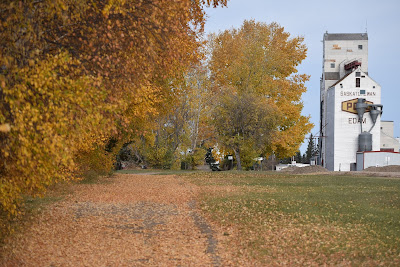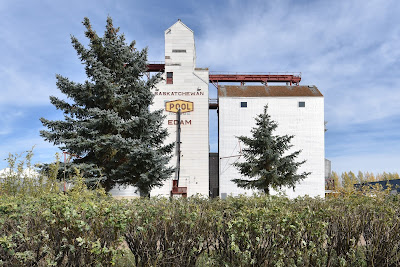Their Hopes our Heritage : Vawn to Edam
As we set out this morning we were greeted with a clear blue sky that was tinged with pink from the rising sun. Overhead a continuous stream of Snow Geese stretched from one horizon to the other, forming a living, moving, glittering band. Pockets of silvery blue frost clung to the grasses in the shadows and dips as long as they could, but they were soon chased away by the warmth of the rising sun. As golden light flooded the fields and our long shadows stretched out before us on the gravel road, a female elk bounded off across the fields. We felt lucky to be immersed in such a magical world.
Those first hours of the morning, when everything feels peaceful and quiet, are my favourite time of day. We enjoyed a pleasant walk, passing pastures filled with curious cows, grazing Canada Geese, and Snow Geese looking like drifts of snow. Inviting tracks and curving lane ways wound off into forests still bright with the yellows and oranges of fall. It was easy to imagine the crunch of leaves beneath our boots and the smell of fallen leaves if we'd gone to explore these enticing side trails. Instead, we continued down our gravel road, noticing beautiful wooden buildings and abandoned barns tucked into fields and stands of trees along the way.
While enjoying the beautiful morning we had lots to occupy our minds with. Today is the first National Day for Truth and Reconciliation, meant to promote awareness and education about the Residential Schools, and to honour all the First Nations' children and their families who survived, as well as all those who didn't. One of the things I've realized on this hike across Canada is that I personally tended to think of First Nations as the Peoples that came before the settlers, and the Treaties as something that happened in the past. As we've hiked across the country we've seen how many First Nations communities exist on this land, and while some are thriving, others are really struggling as a result of our painful shared history. As we read at the Wanuskewin Centre outside Saskatoon 'We are all Treaty people', meaning we all have a responsibility to uphold the agreement to protect and care for the lands we occupy - it is not something that is over and done with, or something that exists only between the First Nations and the government. This likely should have been obvious to me from the start, but nonetheless, it provides lots of food for thought on how we can build trust and move forward to repair some of the cultural and environmental damage that has been done.
As we headed north towards the highway we passed the Husky Edam East Thermal Facility, and traffic began to really pick up. This $350 million heavy oil extraction plant is part of the Calgary based company's plan to expand its operations in this area. It will provide over 300 construction jobs as the new plants are built at a rate of two per year, and around 30 permanent, full-time positions in each one once they are operational. Without a doubt it is massive and like the other facilities here has transformed not only the landscape but also the communities around it.
We hadn't realized there were oil fields in Saskatchewan, and it was interesting to see the various tanks, pumps, disposal sites, and related infrastructure scattered among fields occupied by crops and grazing cows. In addition to the 'No Hunting' signs on the fences that surrounded the pastures, there were warnings for 'High Pressure Oil Pipeline', 'High Pressure Water Pipeline,' and 'Danger of Explosion.' The land in this area really is being 'put to use' in every possible way, both above and below the surface.
Although there was a lot of traffic, the silver lining for us was a short stretch of very well-compacted road, followed by a short piece of pavement! We glided along almost effortlessly for a few minutes, a lovely forest on one side and a large blue lake on the other. Sandwiched between the water and the road was a herd of cows, some of which mooed loudly as we passed, their low voices seeming to reverberate from deep within them.
By mid-morning we reached the village of Edam, which is a small community of 480 residents located on Highway 26. There is a small replica of a windmill at the entrance to the hamlet, which is known as a 'Little Piece of Holland in Saskatchewan.' The community was founded in 1907 by Dutch settlers and named after a town in the Netherlands. Originally the settlers had wanted to call it 'Amsterdam', but the provincial government declared that was too long.
As we approached the downtown we passed an old wooden grain elevator, which looked like it might still be in operation. We followed a beautiful section of crushed stone dust trail bordered by golden birch trees, and complete with several benches in to town. The Trans Canada Trail was listed as a tourist attraction for the town, and it is easy to see that a lot of work has gone into creating a lovely pathway here!
We made our way through town, past a Senior Centre, a large Community Centre, a school covered by colourful murals, an elegant church, and a main street with a general store, a restaurant, a bar, and a post office. As we sat outside the general store enjoying an iced tea, a man approached us and asked if we were staying in the campground for the night. We hadn't heard back from them, so assumed they were closed for the season or not accepting tent campers, but when we learned we could camp for the night we decided to stop, even though we only walked 15 km today.
The Drop Anchor RV Park turned out to be a lovely campground with extremely clean washroom and shower facilities, and laundry! We spent a long time speaking with the owner, who remembered Mel and Malo, as well as Diane Whelan, who also came to stay for a couple days! Interestingly, he is also one of the volunteer trail builders for this section of Trans Canada Trail, so it is partially thanks to his efforts that there is such a lovely pathway through town.
He offered us a complimentary campsite for the night, volunteered to bring us an extension cord so we could recharge everything, and let us know there was WiFi. His thoughtful kindness was very much appreciated. Perhaps best of all, he shared a huge black book with us, called 'Their Hopes, Our Heritage' detailing the history of the region, as well as the families that settled here. We were so happy to learn that someone had collected the stories of the early settlers, local communities and regional before they faded from memory and were lost to history.
From the historical accounts we learned that Edam sits at a crossroads of the Paynton, Carleton and Fort Pitt Trails. It is also located only 14 miles southeast of Pine Island, which was an important locus of the Fur Trade on the Saskatchewan River during the late 1780's. During the winter of 1787-88 three factions were competing for their share in the fur trade - representatives from the Hudson's Bay Company, the North West Company, and private partners Donald McKay and Alexander Shaw.
Like many other prairie communities, Edam has been an important location in the prairies and its fortunes have risen and fall in relation to its grain elevator, its place on the railway line, as a stop-over on the highway, and now because of the oil fields. The sense of community and mutual respect for one another which can be felt throughout the town is wonderful to see and experience.
While for many the prairies are fly over regions and often dismissed as places where "just" wheat is grown. Yet the fact is that in many rural communities like Edam, history has repeatedly converged, Canada as a nation has been defined, and in many ways our country's future as well as the direction it takes will be determined. I have a grate deal of envy for those communities across Canada where people still chat with one another, individuals still work together building local parks, and where people support community businesses. I believe, that we would all do better if we took the time to know our neighbours, know more about our communities, and to learn more about each region in this nation - because in the process we would also learn more about ourselves and remember the Common Ground that we all have as Canadians.
Edam might seem to be 'just another' small, quiet, and charming town but I am grateful for time we have spent in communities just like it across the prairies. We are grateful to meet and talk with so many of the amazing regular Canadians here, and grateful to have had the opportunity to connect with and learn from those who live and work hard out here. Whether outside a coffee shop, talking on the side of the road during the harvest, chatting over the fence line at a ranch or by a oil refinery with tradespeople we have both learned a lot - by listening.
While I certainly have my own views on events and our country (as does everyone), I also have to admit that there is certainly no denying that there are valuable perspectives into the nation and ideas about our future which need to be listened to and learned from in each small town across Canada.
Perhaps the main lesson his year is that we have a much more in common with each other than polls, political maps, and elections reveal. We are not divided by politics and need not be separated by geography or by whether we live in a megacity or close knit community. The simple fact is that as Canadians we are stronger together, and have common aspirations - just so long as we are willing to once again listen to one another and learn from one another.
See you on the trail!
Remember to follow our entire adventure here : www.comewalkwithus.online




























Comments
Post a Comment